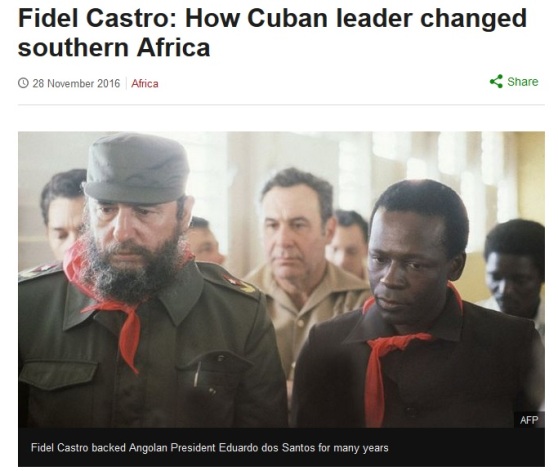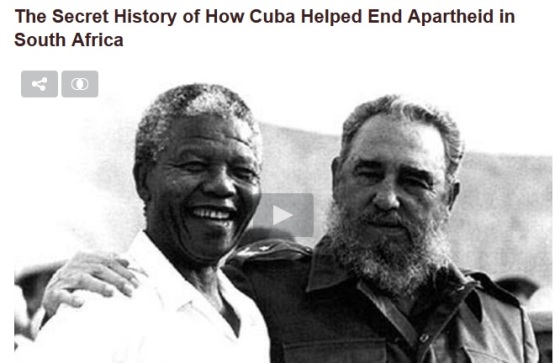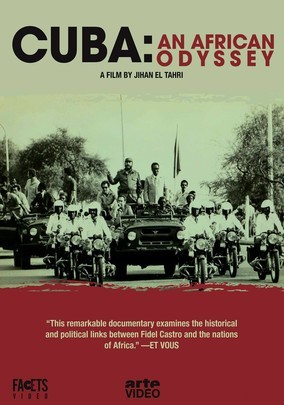With the passing of Fidel Castro, a lot has been written about his influence in Latin America, but Castro also had a profound impact on southern Africa, as well.
In Cuba it seems there will forever be two histories of Fidel Castro.
One is the revolutionary who succeeded and became the guiding star for all who saw the world through the lens of Marxist Leninism.
The other is the brutal dictator who suppressed democracy and kept his country poor.
There is one place where Castro undoubtedly made a difference: southern Africa.
The main presence of Cuba on the African continent was in Angola, which became a Cold War battleground in the 1970s and ’80s.
“The collapse of the Portuguese dictatorship in April 1974 opened the first fissures in the dam that protected white rule,” Piero Gleijeses, professor of American foreign policy at Johns Hopkins University, states in his book, Visions of Freedom: Havana, Washington, Pretoria & the Struggle for Southern Africa, 1976-1991, points out. The Portuguese colonies of Angola and Mozambique became independent, and suddenly apartheid South Africa was nervous of these free black states in their neighborhood of southern Africa.
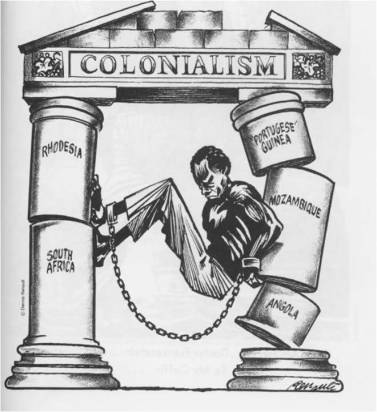
Almost immediately, the South African and US governments intervened to install a regime that was allied with the West as opposed to one that would be allied with the Soviet Union. Pretoria and Washington worked together to crush the left-wing Popular Movement for the Liberation of Angola (MPLA), and the Soviet Union and Cuba worked together to support the MPLA. As Piero Gleijeses points out, “Southern Africa had been hurled into the vortex of the Cold War.”
The Russians sent about 1,000 advisers and money but no combat troops. East Germany also sent military assistance.
Castro, however, saw an opportunity to exert his brand of international solidarity and make a difference on a global scale.
Between November 1975 and April 1976, 36,000 Cuban soldiers, as well as military advisers, tanks, and fighter aircraft, poured into Angola in an effort to help a new nation maintain its independence from the West.
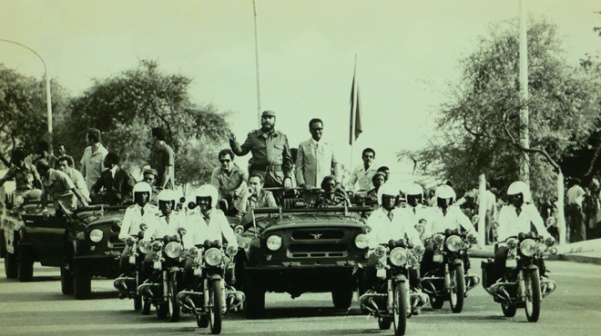
Fidel Castro in Angola with President Agostinho Neto (r. 1975-79)
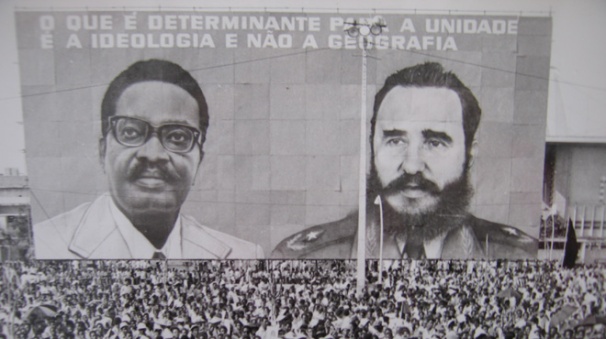
Poster of President Agostinho Neto and Fidel Castro after Angolan independence celebration
By April 1976 the Cubans had pushed the South Africans out of Angola. For the next fifteen years – until 1991 – tens of thousands of Cuban soldiers remained in Angola. Their number peaked at 55,000 in 1988.
The Cuban role in Angola is without precedent. No other Third World country has projected its military power beyond its immediate neighborhood. Brazil sent troops to the Dominican Republic in 1965; Argentina briefly intervened in Nicaragua in 1980-81; China’s military activities outside Asia were limited to the supply of weapons and the dispatch of a few hundred instructors to Africa.
Africans, Americans, Cubans, and Soviets jostled in a confusing landscape. They fought over the future of Angola and the decolonization of Namibia, Africa’s last colony. Beyond lay the great prize: South Africa.
In Angola in the late 1970s and 1980s, the left-wing MPLA government faced two enemies bent on its destruction: the rebel leader Jonas Savimbi (leader of the National Union for the Total Independence of Angola (UNITA)), and the South African government. Pretoria was well aware of the MPLA’s commitment to help those who fought for the eradication of apartheid; therefore, the MPLA had to be destroyed. The South Africans bolstered Savimbi with economic and military aid. But the South Africans did more than help Savimbi: they waged war on Angola for longer than a decade, sending their troops at will into the south of the country to defeat the MPLA.
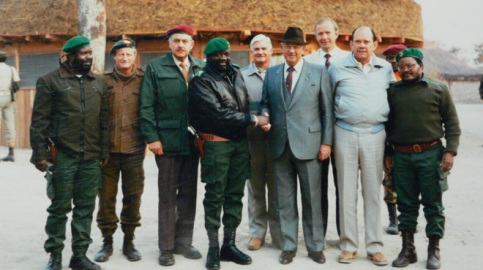
South African President PW Botha visits UNITA’s Jonas Savimbi
Sandwiched between Angola and South Africa is Namibia. It had been a German colony before falling under a South African mandate at the close of World War I. South Africa had subsequently ruled it its own province. In 1971 the International Court of Justice and the UN Security Council had decreed Pretoria’s occupation of the country illegal and ordered it to withdraw immediately. South African officials knew that if Namibia were ever truly independent, it would have “an extremely negative impact on every front” for the apartheid regime. It would encourage “black militant groups in South Africa . . . [and] lead to a decline in white morale.”
In the shadows was the South West Africa People’s Organization (SWAPO), the Namibian guerrilla movement that challenged Pretoria’s rule. SWAPO, a U.S. ambassador to South Africa wrote in 1977, “has, over the years, in the mind of the [Namibian] population come to symbolize independence, equal rights, and freedom from South Africa.” SWAPO, South African officials lamented, would win any free election; therefore, the UN-supervised elections that the international community demanded could never be allowed to happen. South Africa would never give up Namibia unless they were militarily forced to.
The SWAPO guerrillas were based in Angola, where the MPLA government gave them what, a South African general wrote, “is virtually a prerequisite for a successful insurgent campaign, namely a border that provided safe refuge.” In Angola, the SWAPO guerrillas were trained by Cuban and Soviet instructors.
Like SWAPO, the African National Congress had its military camps in Angola where its fighters were also trained by Cuban instructors and armed by the Soviet Union.
Thus there was a complex and deadly interplay between Angola, Namibia, and South Africa. The MPLA helped SWAPO and the ANC, which fought against apartheid South Africa. The South Africans, in turn, wanted to topple the MPLA and hold on to Namibia.
The Cuban soldiers, armed by the Soviet Union, protected the MPLA government and thereby protected SWAPO and the ANC. Even the CIA acknowledged that the Cuban troops were “necessary to preserve Angolan independence.” Nevertheless, their presence there was intolerable to the US, which was seeing the world only through their Cold War-colored glasses.
It was through this lens that the US shamefully aided and supported the apartheid regime and its allies, while Cuba supported the anti-apartheid movement and its allies.
The first attacks were in 1983 and a full-scale battle took place in 1986 – the biggest battle in Africa since El Alamein in Egypt in 1942.
Cuba played a key role in deciding the fate of southern Africa. It was the Cubans who pushed the Soviets to help Angola. It was they who stood guard in Angola for years, thousands of miles from home, to prevent the South Africans from overthrowing the MPLA government. It was they who in 1988, with the reinforcements Castro sent, forced South Africa to concede defeat at the Battle of Cuito Cuanavale, and in doing so, forced the South African army out of Angola.
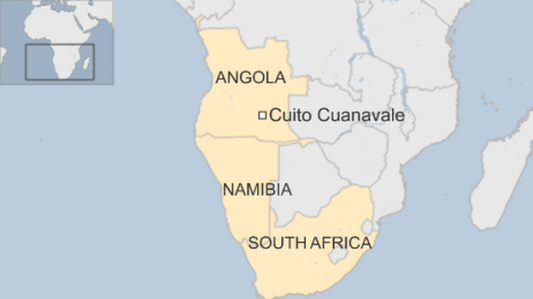
It was Cuba’s victory in Angola in 1988 that forced Pretoria to abandon Savimbi and UNITA and hold free elections in Namibia – which SWAPO subsequently won. It was they who ultimately forced both PW Botha and FW de Klerk to the negotiating table and helped break the back of apartheid South Africa.
Cuba ultimately ended its combat mission in Angola in 1991 after the South African military was defeated and forced to withdraw from Angola and grant independence to nearby Namibia.
In the words of Piero Gleijeses, “Cuba changed the course of history in southern Africa.”
Cuba played such an important role in helping bring down apartheid and free South Africa that Nelson Mandela traveled to the island in 1991 to publicly thank Fidel Castro and the Cuban people for their help. During his speech, Mandela said it was the Cubans who “destroyed the myth of the invincibility of the white oppressor … [and] inspired the fighting masses of South Africa.”
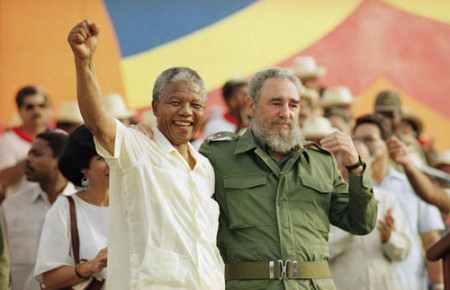
Mandela and Castro in Cuba in 1991
“The defeat of the apartheid army served as an inspiration to the struggling people of South Africa,” Mandela continued. “In Africa we are used to being victims of countries that want to take from us our territory or overthrow our sovereignty. In African history there is not another instance where another people has stood up for one of ours.”
According to Piero Gleijeses, “Cuba is the only country in the world that sent its soldiers to confront the army of apartheid and defeated the army of apartheid, the South African army, twice—in 1975-1976 and in 1988.”
Nelson Mandela clearly recognized this when he made Fidel Castro the guest of honor at his inauguration ceremony in 1994 upon being named South Africa’s first black president.
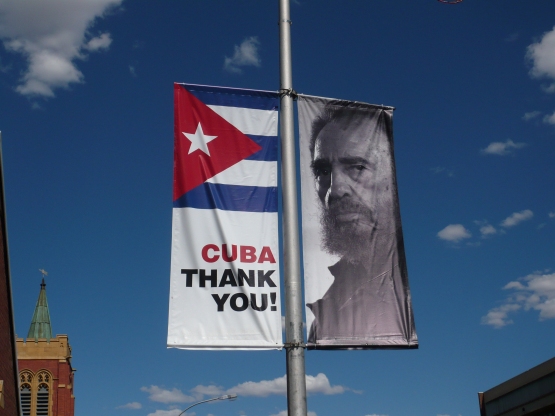
Bloemfontein, South Africa — a banner thanking Cuba as part of the ANC Centenary in 2012
To learn more about the fascinating role that Castro and Cuba has played in southern Africa, check out the documentary, Cuba: An African Odyssey:

